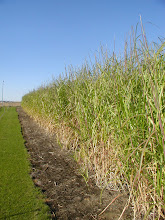I wanted to share a little of the information from a white paper we wrote last year which combined and analyzed information from a few of the government studies which have been published regarding biomass supply. The paper identifies some of the biomass sources and talks about how as we develop commercial scale biomass based projects the sustainable production and logistics of providing biomass is going to be the major contributor to the success of the project outside the processing technology itself. If you are interested in receiving the “Feedstock Supply Solutions for Biomass Based Renewable Energy Companies and Rural Economic Development” white paper drop me a note and I will send a copy.
In this white paper we discuss how the actual demand for biomass is may go well beyond the billion tons per year as mentioned in these studies as economic conversion technologies develop. We contend that it will be 1.2 - 2.0 billion tons per year in the foreseeable future depending on our desire to reduce dependence on fossil fuels. It also details existing biomass resources and opportunities.
Let's take a quick look at the biomass sources.
Forest Biomass - The DOE/USDA Billion - Ton report shows 368 million tons of forest resources available annually in the US. This breaks down into 141 million tons in use already, 139 million tons available with better land management, and 88 million tons not currently utilized. This leaves 227 million tons potential forest based biomass for use.
Municipal Solid Waste (MSW) - MSW Municipal solid waste is getting much attention as a potential feedstock for renewable applications. MSW has some very attractive qualities. It is a feedstock which is generated in center of population. The use of MSW has tremendous greenhouse gas benefits with reductions in methane production and landfill storage requirements. MSW has it's own challenges as a feedstock. We have not studied MSW in detail as it is not currently a part of our operating plans. If future conversion methods for MSW can economically generate liquid fuels or syngas it will be very beneficial.
Agricultural Resources - The DOE and USDA joint report, “Biomass as a Feedstock for a Bioenergy and Bioproducts Industry: The Technical Feasibility of a Billion-Ton Annual Supply,” lays out in great detail three possible scenarios for the availability of biomass feedstock from agricultural lands. In the first scenario with moderate yield increase and no perennial energy crops indicates about 421 million tons annual capacity. In the highest capacity scenario with high yield increases and perennial energy crops the annual capacity is 997 million tons per year. This indicates that agricultural resources can be utilized to produce a significant and possibly the largest portion of our biomass energy feedstock.
The economical challenge with all biomass sources is the delivered price to the conversion facilities. The aggregation and transportation can quickly drive the prices for biomass feedstock out of the economical price range for the conversion facility. The existing market demand is also a concern in biomass sourcing. If a facility will increase regional demand for biomass significantly there will likely be an increase biomass prices overall. Knowing the other uses for biomass and their acceptable levels of feedstock cost is also very important. The facility operator who requires the lowest cost feedstock in the region will surely experience economic troubles down the road.
In order for the biomass industry to grow and survive long term the biomass feedstock supply chain stakeholders need to focus on increasing the production per acre and reducing the total costs to the conversion facility. Conversion facility owners and operators also need to participate in the feedstock supply chain by supporting the producers and developing technologies which will help them reduce the overall costs of biomass to the facilities.
The consistent economical feedstock supply for biomass based operations will continue to be the major challenge in scaling and industry growth. Companies that do not understand the biomass capacity and sourcing very well will not survive.
Subscribe to:
Post Comments (Atom)

No comments:
Post a Comment